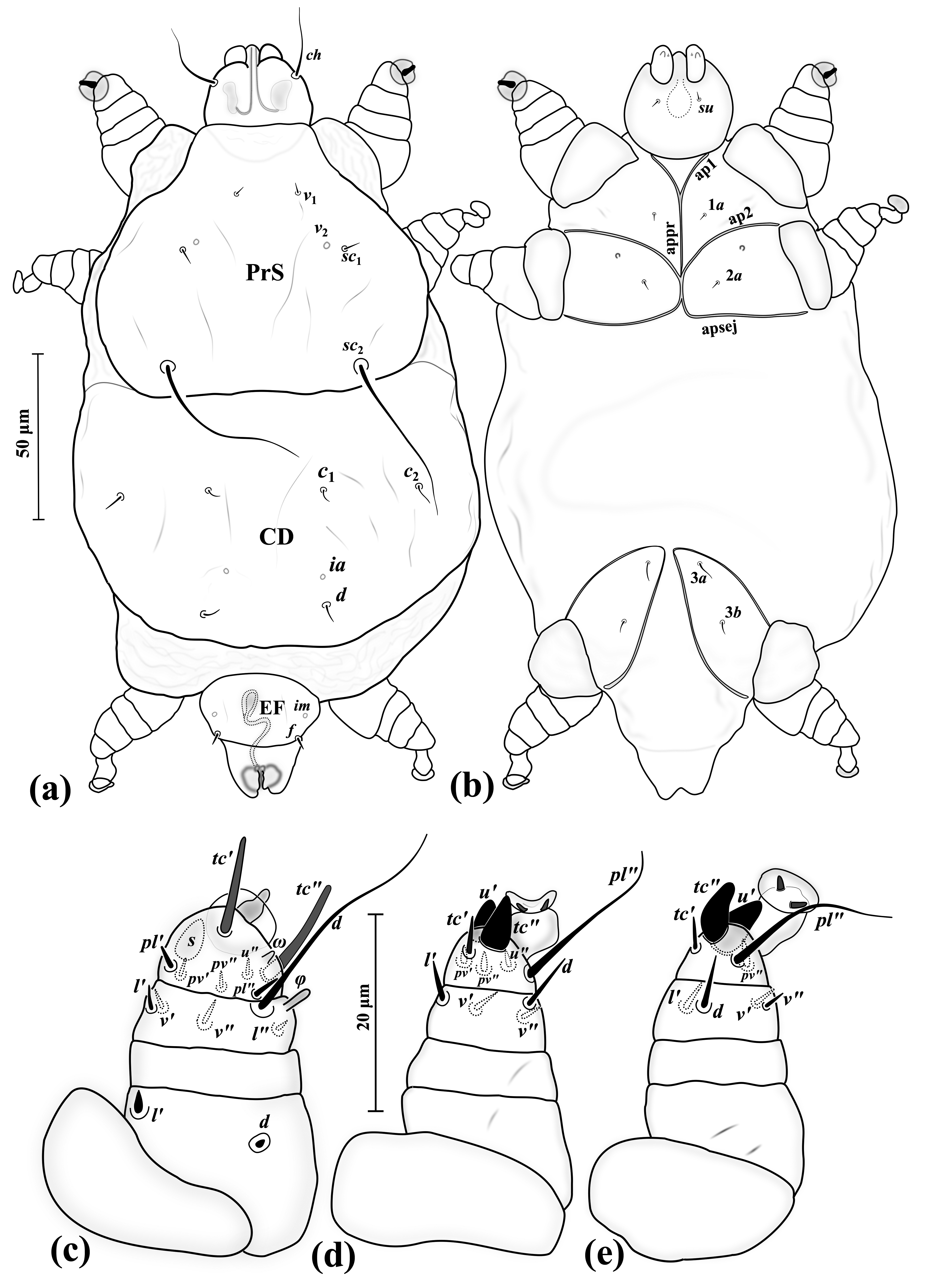|
Riccardoella Limacum
''Riccardoella limacum'' or the white snail mite is a member of the Acari (mite) family which is parasitic primarily on snails. Slug mites are very small (less than 0.5 mm in length), white, and can be seen to move very rapidly over the surface of their host, particularly under the exoskeleton, shell rim and near the pneumostome, pulmonary aperture. While once thought to be benign mucophages, more recent studies have shown that they actually Hematophagy, subsist on the host's blood, and may bore into the host's body to feed. Studies have shown that this species name has been frequently misapplied to the more widespread ''Riccardoella oudemansi'', the white slug mite. Despite its name, ''R. limacum'' is typically a restricted parasite of snails, while ''R. oudemansi'' is the common species on slugs, although it occasionally feeds on snails too. Hosts Mite infection among gastropod populations varies greatly. Dense gastropod population favors infection; isolated populations ... [...More Info...] [...Related Items...] OR: [Wikipedia] [Google] [Baidu] |
Franz Von Paula Schrank
Franz von Paula Schrank (21 August 1747, in Vornbach – 22 December 1835) was a German priest, botanist and entomologist. He was ordained as a priest in Vienna in 1784, gaining his doctorate in theology two years later. In 1786 he was named chair of mathematics and physics at the lyceum in Amberg, and in 1784 became a professor of botany and zoology at the University of Ingolstadt (later removed to Landshut). at Catholic Encyclopedia Schrank was the first director of the botanical gardens in from 1809 to 1832. Schrank was the first author to use the name '' |
Helix Pomatia
''Helix pomatia'', common names the Roman snail, Burgundy snail, or escargot, is a species of large, edible, air-breathing land snail, a pulmonate gastropod terrestrial mollusc in the family Helicidae.MolluscaBase eds. (2021). MolluscaBase. Helix pomatia Linnaeus, 1758. Accessed through: World Register of Marine Species at: http://marinespecies.org/aphia.php?p=taxdetails&id=1050286 on 2021-02-19 It is one of Europe's biggest species of land snail. Distribution Distribution of ''H. pomatia'' includes: Southeastern and Central Europe: * Germany – listed as a specially protected species in annex 1 of the Bundesartenschutzverordnung. * Austria * Czech Republic – least concern species (LC): Its conservation status in 2004–2006 is favourable (FV) in the report for the European Commission in accordance with the Habitats Directive. * Poland * Slovakia * Hungary * Romania * In southwestern Bulgaria up to an altitude more than 1600 m. * Northern and central Balkans * Slove ... [...More Info...] [...Related Items...] OR: [Wikipedia] [Google] [Baidu] |
Trombidiformes
The Trombidiformes are a large, diverse order of mites. Taxonomy In 1998, Trombidiformes was divided into the Sphaerolichida and the Prostigmata. The group has few synapomorphies by which it can be defined, unlike the other major group of acariform mites, Sarcoptiformes. Its members include medically important mites (such as ''Demodex'', the chiggers, and scrub-itch mites) and many agriculturally important species, including the spider mites (Tetranychidae). The superfamily Eriophyoidea, traditionally considered members of the Trombidiformes, have been found to be basal mites in genomic analyses, sister to the clade containing Sarcoptiformes and Trombidiformes. The 2004 classification retained the two suborders, comprising around 125 families and more than 22,000 described species. In the 2011 revised classification, the order now contains 151 families, 2235 genera and 25,821 species, and there were another 10 species with 24 species that present only as fossils. These 151 ... [...More Info...] [...Related Items...] OR: [Wikipedia] [Google] [Baidu] |
Arachnids Of Europe
Arachnida () is a class of joint-legged invertebrate animals (arthropods), in the subphylum Chelicerata. Arachnida includes, among others, spiders, scorpions, ticks, mites, pseudoscorpions, harvestmen, camel spiders, whip spiders and vinegaroons. Almost all adult arachnids have eight legs, although the front pair of legs in some species has converted to a sensory function, while in other species, different appendages can grow large enough to take on the appearance of extra pairs of legs. The term is derived from the Greek word (''aráchnē'', 'spider'), from the myth of the hubristic human weaver Arachne, who was turned into a spider. Almost all extant arachnids are terrestrial, living mainly on land. However, some inhabit freshwater environments and, with the exception of the pelagic zone, marine environments as well. They comprise over 100,000 named species, of which 47,000 are species of spiders. Morphology Almost all adult arachnids have eight legs, unlike adult insects ... [...More Info...] [...Related Items...] OR: [Wikipedia] [Google] [Baidu] |
Hypoaspis Miles
''Stratiolaelaps scimitus'' (formerly ''Hypoaspis miles'') is a small (0.5 mm) light brown mite that lives in the top layer of soil. As a natural predator of fungus gnat pupae and of the snail parasite '' Riccardoella limacum'' it is used by gardeners and snail breeders for biological pest control. ''Stratiolaelaps scimitus'' is also commonly used by reptile, amphibian and invertebrate keepers as a preventative or reactive measure against grain mites and reptile mites. Whereas most mite treatments are based on synthetic chemicals, predatory mites are used as a biological method of preventing and curing mite infestations. ''Stratiolaelaps scimitus'' and the similar species, ''S. aculiefer'' are soil-dwelling, predatory mites. ''Stratiolaelaps'' mites feed on fungus gnats, springtails, thrips Thrips (order Thysanoptera) are minute (mostly long or less), slender insects with fringed wings and unique asymmetrical mouthparts. Different thrips species feed mostly on pl ... [...More Info...] [...Related Items...] OR: [Wikipedia] [Google] [Baidu] |
Pseudomonas Aeruginosa
''Pseudomonas aeruginosa'' is a common encapsulated, gram-negative, aerobic–facultatively anaerobic, rod-shaped bacterium that can cause disease in plants and animals, including humans. A species of considerable medical importance, ''P. aeruginosa'' is a multidrug resistant pathogen recognized for its ubiquity, its intrinsically advanced antibiotic resistance mechanisms, and its association with serious illnesses – hospital-acquired infections such as ventilator-associated pneumonia and various sepsis syndromes. The organism is considered opportunistic insofar as serious infection often occurs during existing diseases or conditions – most notably cystic fibrosis and traumatic burns. It generally affects the immunocompromised but can also infect the immunocompetent as in hot tub folliculitis. Treatment of ''P. aeruginosa'' infections can be difficult due to its natural resistance to antibiotics. When more advanced antibiotic drug regimens are needed adverse effects may re ... [...More Info...] [...Related Items...] OR: [Wikipedia] [Google] [Baidu] |
Nematode
The nematodes ( or grc-gre, Νηματώδη; la, Nematoda) or roundworms constitute the phylum Nematoda (also called Nemathelminthes), with plant-Parasitism, parasitic nematodes also known as eelworms. They are a diverse animal phylum inhabiting a broad range of environments. Less formally, they are categorized as Helminths, but are taxonomically classified along with Arthropod, arthropods, Tardigrade, tardigrades and other moulting animalia, animals in the clade Ecdysozoa, and unlike platyhelminthe, flatworms, have tubular digestion, digestive systems with openings at both ends. Like tardigrades, they have a reduced number of Hox genes, but their sister phylum Nematomorpha has kept the ancestral protostome Hox genotype, which shows that the reduction has occurred within the nematode phylum. Nematode species can be difficult to distinguish from one another. Consequently, estimates of the number of nematode species described to date vary by author and may change rapidly over ... [...More Info...] [...Related Items...] OR: [Wikipedia] [Google] [Baidu] |
René Antoine Ferchault De Réaumur
René Antoine Ferchault de Réaumur (; 28 February 1683, La Rochelle – 17 October 1757, Saint-Julien-du-Terroux) was a French entomologist and writer who contributed to many different fields, especially the study of insects. He introduced the Réaumur temperature scale. Life Réaumur was born in a prominent La Rochelle family and educated in Paris. He learned philosophy in the Jesuits' college at Poitiers, and in 1699 went to Bourges to study civil law and mathematics under the charge of an uncle, canon of La Sainte-Chapelle. In 1703 he went to Paris, where he continued the study of mathematics and physics. In 1708, at the age of 24, he was nominated by Pierre Varignon (who taught him mathematics) and elected a member of the Académie des Sciences.Egerton, F. N. 2006A History of the Ecological Sciences, Part 21: Réaumur and His History of Insects Bulletin of the Ecological Society of America 87(3):212–224. From this time onwards for nearly half a century hardly a y ... [...More Info...] [...Related Items...] OR: [Wikipedia] [Google] [Baidu] |
Oxychilus Draparnaudi
''Oxychilus draparnaudi'', or Draparnaud's glass snail, is a species of small land snail, a terrestrial pulmonate gastropod mollusc in the family Oxychilidae, the glass snails. Description ''Oxychilus draparnaudi'' is large for a zonitid glass snail, also called the dark-bodied glass snail with a shell of about 14 mm in maximum dimension. The shell is glossy and is a translucent yellowish-brown and gold in color, somewhat whiter underneath.Janus H. (1965) ''The young specialist look at land and freshwater molluscs'' Burke, London. The visible soft parts of the animal are a very unusual strong dark blue, mixed with grey. File:Oxychilus draparnaudi 01.JPG, Shell of an Adult specimen (Ø 1,3 cm) File:Oxychilus draparnaudi 02.jpg, Shell of a Juvenile specimen (Ø 4 mm) Distribution This species occurs in countries and islands including: * Czech Republic * Slovakia * UkraineBalashov I. & Gural-Sverlova N. 2012. An annotated checklist of the terrestrial molluscs of Ukraine. ... [...More Info...] [...Related Items...] OR: [Wikipedia] [Google] [Baidu] |
Milax Gagates
''Milax gagates'', known by the common name greenhouse slug, is a species of air-breathing, keel (slug), keeled, land slug, a shell-less terrestrial molluscs, terrestrial gastropod mollusc in the family Milacidae.Marshall, B. (2014). Milax gagates (Draparnaud, 1801). Accessed through: World Register of Marine Species at http://www.marinespecies.org/aphia.php?p=taxdetails&id=819993 on 2014-11-06 Description The body of ''Milax gagates'' is an even dark grey to black, although it has somewhat lighter sides. There are no pigment spots. The mantle (mollusc), mantle is relatively large (35-40% of body length), with distinct grooves. The keel is prominent between mantle and posterior end.This article incorporates public domain text from the reference"Species summary for ''Milax gagates''" AnimalBase, last modified 30 December 2008, accessed 26 August 2010.) Skin sculpture is weak. There are 16-17 grooves between keel and pneumostome. The sole of the foot has blackish lateral zones and ... [...More Info...] [...Related Items...] OR: [Wikipedia] [Google] [Baidu] |
Milax Budapestensis
Milax may refer to: *Milax, Azerbaijan Milax (also, Milakh) is a village and municipality in the Julfa District of Nakhchivan, Azerbaijan. It is located 55 km in the north from the district center, on the right bank of the Alinjachay River, on the slope of the Zangezur ridge. Its ... * ''Milax'' (gastropod), a genus of land slugs in the family Milacidae {{Disambiguation ... [...More Info...] [...Related Items...] OR: [Wikipedia] [Google] [Baidu] |





